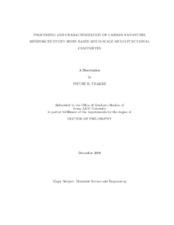| dc.contributor.advisor | Lagoudas, Dimitris C. | |
| dc.creator | Thakre, Piyush R. | |
| dc.date.accessioned | 2011-02-22T22:24:24Z | |
| dc.date.accessioned | 2011-02-22T23:49:07Z | |
| dc.date.available | 2011-02-22T22:24:24Z | |
| dc.date.available | 2011-02-22T23:49:07Z | |
| dc.date.created | 2009-12 | |
| dc.date.issued | 2011-02-22 | |
| dc.date.submitted | December 2009 | |
| dc.identifier.uri | https://hdl.handle.net/1969.1/ETD-TAMU-2009-12-7638 | |
| dc.description.abstract | This research is focused on investigating the effect of carbon nanotubes on
macroscale composite laminate properties, such as, interlaminar shear strength, interlaminar fracture toughness and electrical conductivity along with studying the
micro and nano-scale interactions of carbon nanotubes with epoxy matrix via thermomechanical and electrical characterization of nanocomposites. First an introduction
to the typical advanced composite laminates and multifunctional nanocomposites is
provided followed by a literature review and a summary of recent status on the processing and the characterization work on nanocomposites and composite laminates.
Experimental approach is presented for the development of processing techniques and
appropriate characterization methods for carbon nanotubes reinforced epoxy resin
based multi-functional nanocomposites and carbon fiber reinforced polymer composite laminates modified with carbon nanotubes. The proposed work section is divided
into three sub-sections to describe the processing and the characterization of carbon nanotube reinforced epoxy matrix nanocomposites, woven-carbon fabric epoxy
matrix composite laminates modified with selective placement of nanotubes and unidirectional carbon fiber epoxy matrix composite laminates modified with carbon nanotubes.
Efforts are focused on comparing the effects of functionalized and unfunctionalized carbon nanotubes on the advanced composite laminates. Covalently functionalized carbon nanotubes are used for improved dispersion and fiber-matrix bonding
characteristics and compared with unfunctionalized or pristine carbon nanotubes.
The processing of woven carbon fabric reinforced epoxy matrix composite laminates
is performed using a vacuum assisted resin transfer molding process with selective
placement of carbon nanotubes using a spraying method. The uni-directional carbon
fiber epoxy matrix pre-preg composites are processed using a hot press technique
along with the spraying method for placement of nanotubes. These macroscale laminates are tested using short beam shear and double cantilever beam experiments for
investigating the effect of nanotubes on the interlaminar shear stress and the interlaminar fracture toughness. Fractography is performed using optical microscopy and
scanning electron microscopy to investigate the structure-property relationship. The
micro and nano-scale interactions of carbon nanotubes and epoxy matrix are studied
through the processing of unfunctionalized and functionalized single wall carbon nanotube reinforced epoxy matrix nanocomposites. The multifunctional nature of such
nanocomposites is investigated through thermo-mechanical and electrical characterizations. | en |
| dc.format.mimetype | application/pdf | |
| dc.language.iso | en_US | |
| dc.subject | Fracture | en |
| dc.subject | carbon nanotubes | en |
| dc.subject | carbon fiber composites | en |
| dc.subject | structure-property relationships | en |
| dc.title | Processing and Characterization of Carbon Nanotubes Reinforced Epoxy Resin Based Multi-scale Multi-functional Composites | en |
| dc.type | Book | en |
| dc.type | Thesis | en |
| thesis.degree.department | Aerospace Engineering | en |
| thesis.degree.discipline | Materials Science and Engineering | en |
| thesis.degree.grantor | Texas A&M University | en |
| thesis.degree.name | Doctor of Philosophy | en |
| thesis.degree.level | Doctoral | en |
| dc.contributor.committeeMember | Ounaies, Zoubeida | |
| dc.contributor.committeeMember | Sue, Hung-Jue | |
| dc.contributor.committeeMember | Creasy, Terry | |
| dc.type.genre | Electronic Dissertation | en |
| dc.type.material | text | en |


